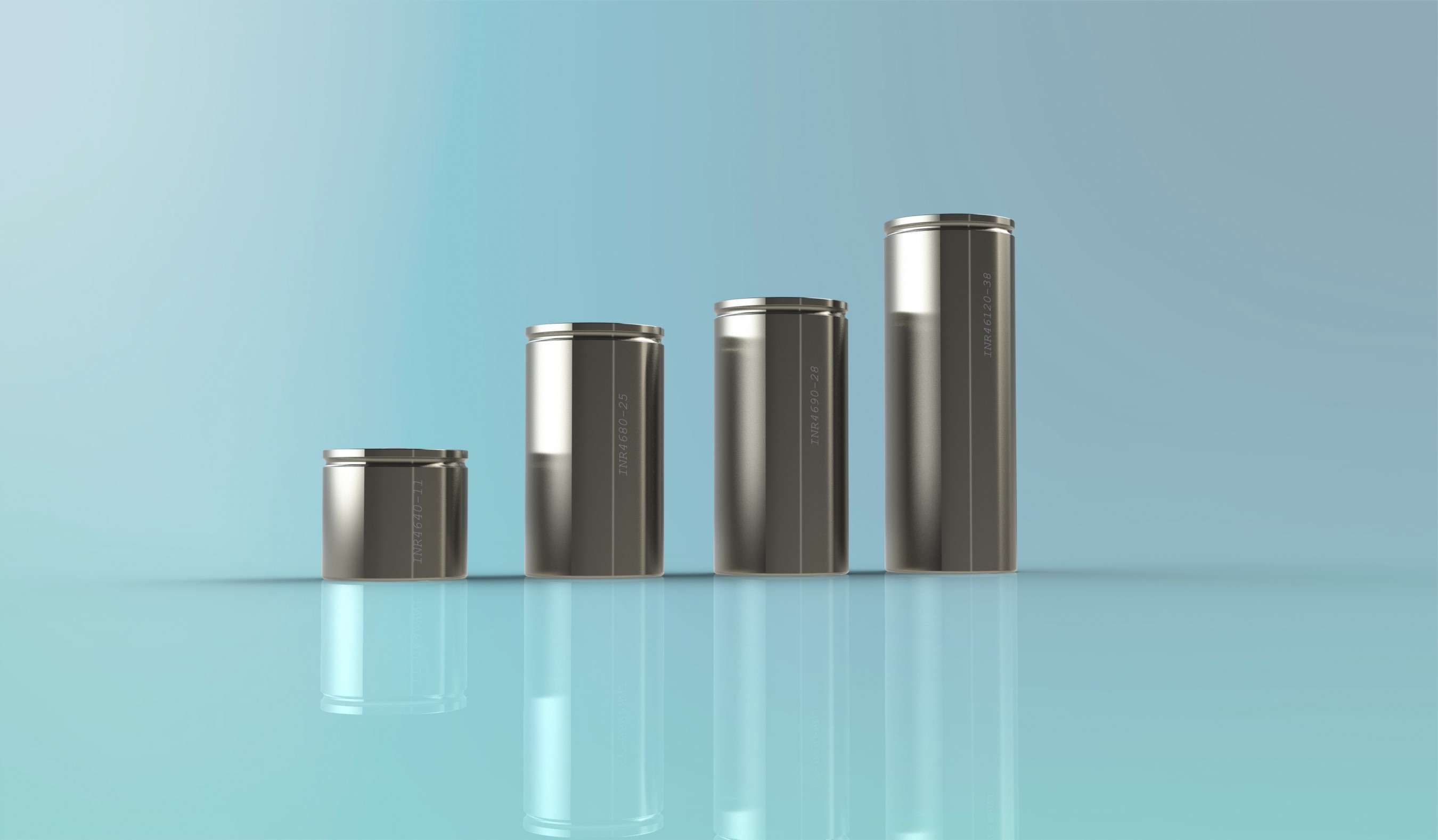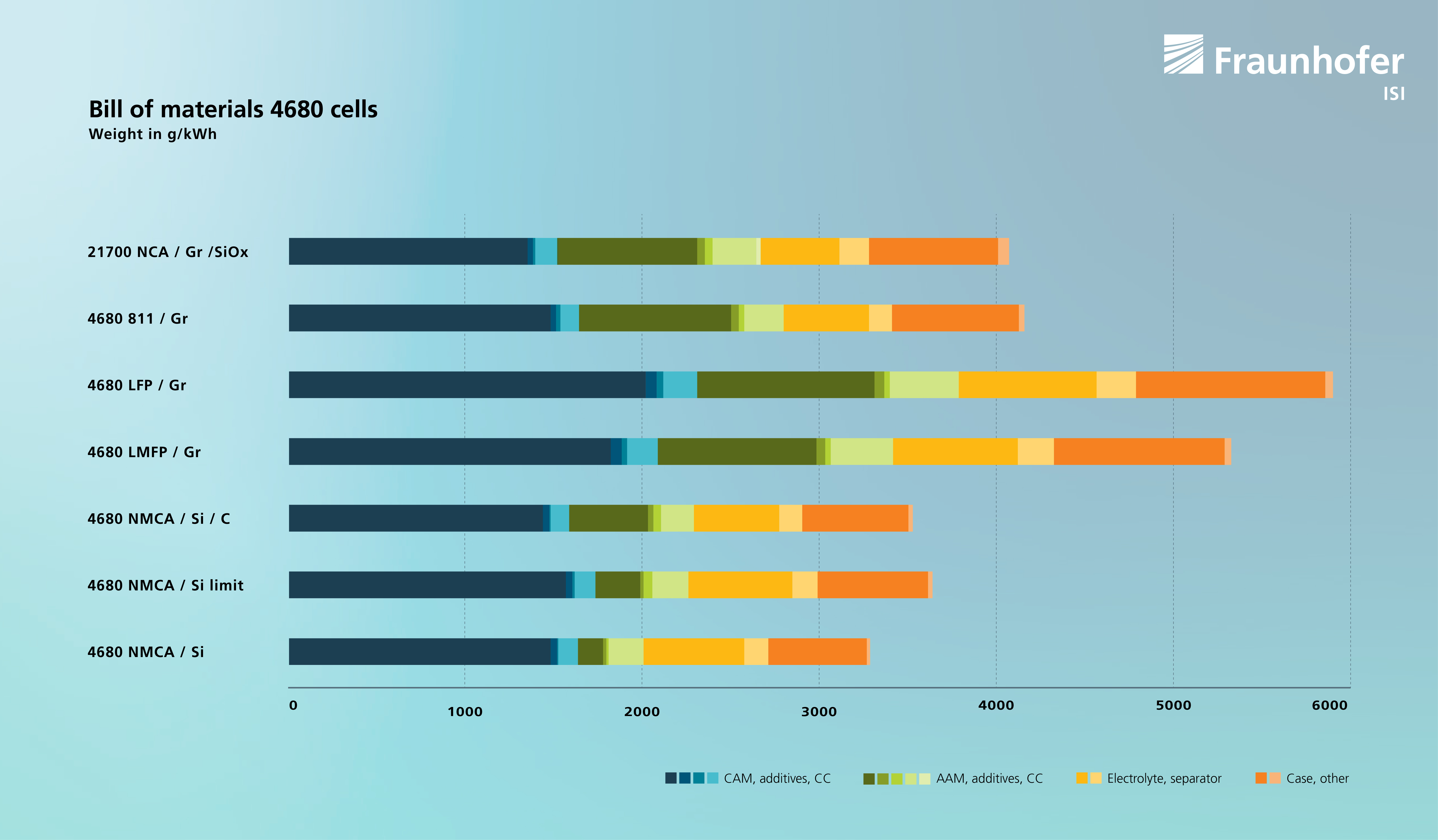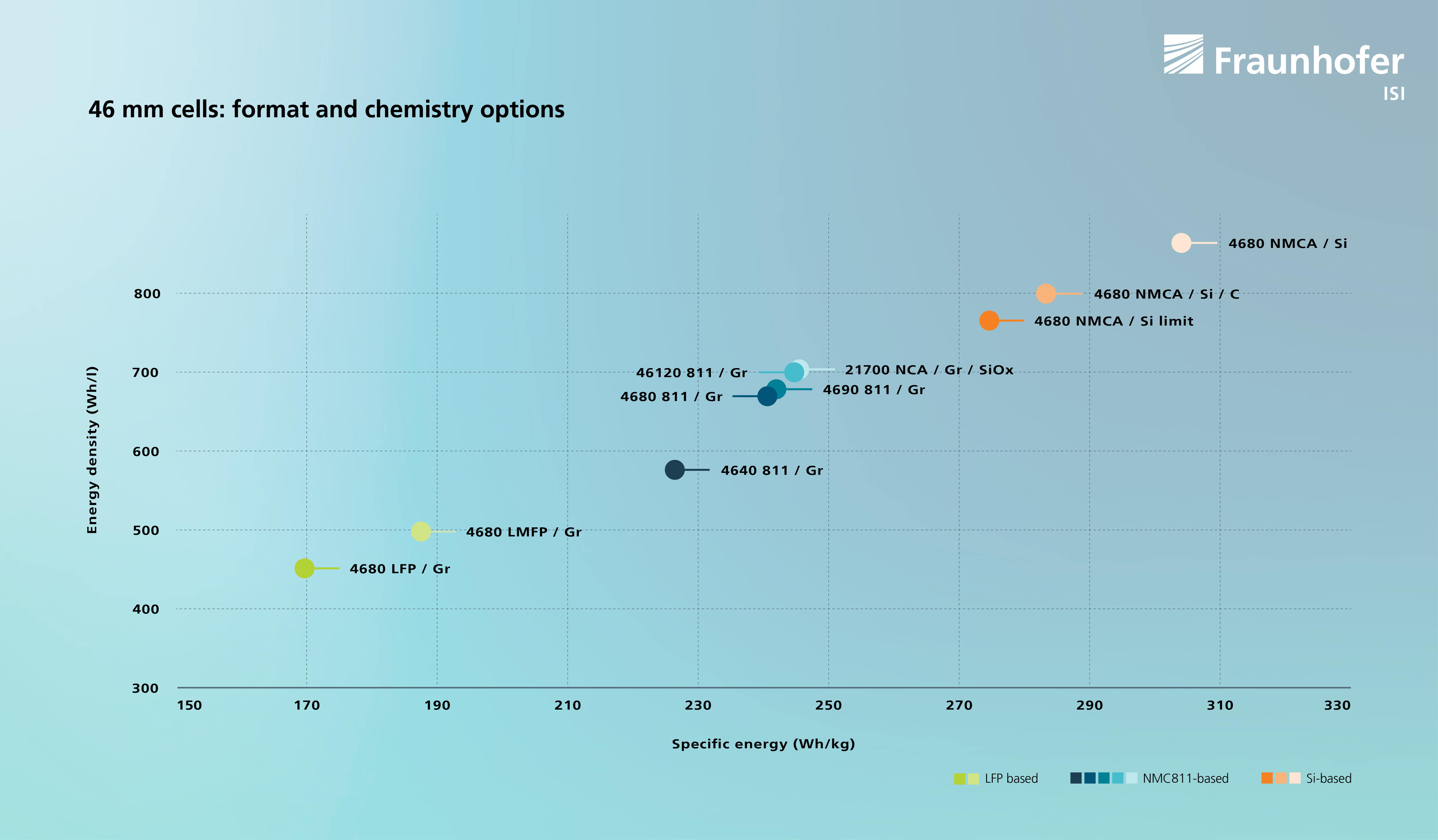Potentials of 46 mm cylindrical cells: On the way to the new standard format
Tesla is giving the go-ahead for a new cylindrical cell format, setting a trend that is also being picked up by other cell manufacturers and vehicle manufacturers.
Since Elon Musk announced the future use of a new battery cell format of type 4680 at the Tesla Battery Days two and a half years ago, a real boom has arisen around the new cylindrical cell. Although the cell with a diameter of 46 mm and a length of 80 mm has so far only been used in some Tesla Model Y vehicles, the expressions of interest and announcements of use are increasing, especially from the automotive sector. In addition to Tesla as the first mover, OEMs such as BMW, Nio and GM have already announced their intention to use the system in the future. At the same time, the field of cell manufacturers is also expanding, which are creating production capacities or at least aiming to build up manufacturing competencies.
LGES wants to ramp up its sample line in the South Korean Ochang this year, Panasonic its large-scale production line in the Japanese Wakayama. Manufacturers Samsung SDI and BAK are also working on pilot production, and as qualified suppliers to BMW, CATL and EVE Energy have already been contracted to build gigafactories.
In the automotive industry, much is promised from the cell: High power density and fast charging capability, more efficient integration in the battery pack or vehicle chassis, and cost advantages due to the simpler cell manufacturing processes typical for cylindrical cells. Although the cell type can be described as large compared to other cylindrical cell formats such as 18650 and 21700, it is still significantly smaller in dimensions and cell capacity compared to prismatic cell formats of the latest generation. A 46 mm cell with 80 mm height, for example, has an internal volume of about 120 ml. A cell of the "blade" type from the manufacturer BYD has a volume of just under 1.2 liters.

For OEMs, the use of the new cylindrical cells could therefore still involve a comparatively high integration effort. At the same time, however, there is flexibility in the mechanical and electrical design of the pack: Nio and BMW, for example, have announced their intention to use an 800 V architecture in the future. Such high system voltages are unlikely to be achievable in series connection due to the low number of individual cells with particularly large-format cells. With the new 4680 cylindrical cells, the high system voltage is achievable in typical packs even with parallel connection of 3 to 5 cells.
Advantages and disadvantages of the new cell design
In addition to the 4680 cell originally announced by Tesla, other formats are now under discussion, ranging from a height of 40 mm to 120 mm. To analyze possible properties, we have looked at some of the cells using Fraunhofer ISI's own cell design tool.
In principle, different material combinations and electrode designs are possible. According to initial tear-down reports, Tesla appears to be using a combination of NMC811 (lithium-nickel-cobalt-aluminum-oxide with 80% nickel) and graphite in the first generation of cells, a material system that can be considered state of the art today. New in the cell design, however, could be the particularly thick electrodes. The extent to which this is made possible by the dry coating of the anode, also used by Tesla, is not yet known.
The electrode combination we have assumed, consisting of a 100 µm thick graphite anode and an 85 µm thick NMC811 cathode, results in an electrode length of about 3.5 m, with the anode or copper foil as the outermost layer probably being about 20 cm longer. With an average cell voltage of just under 3.7 V, which is typical for these materials, the cell has a capacity of about 25 Ah and thus achieves an energy density of just under 700 Wh/l or 250 Wh/kg. The cell thus definitely manages to reach the energy range of the already known 21700 cell, but remains somewhat below it. This is due in particular to the weight of the anode and cathode active materials. Without the addition of silicon oxide in the anode or the high specific capacity of the NCA material (lithium-nickel-cobalt-aluminum-oxide) previously used in the 21700 cell, the achievable capacities of the active materials are lower. To what extent the use of the dry coating process is responsible for the omission of silicon additives is still unclear. Cost factors or advantages in balancing the anode and cathode could speak in favor of the use of NMC811 compared to NCA. The new cell design scores points for the weight of current collectors and separators, which are smaller due to the thickness of the electrodes. Despite a considerable increase in the wall thickness of the steel housing of the cells from 300 to 600 µm, this weight contribution remains almost the same relative to the storage capacity between 21700 and 4680, as can be seen in Figure 2.

The particular characteristics of the cell design are especially noticeable when comparing the dis-cussed cell heights. For this purpose, we analyzed cells with a height of 40 mm to 120 mm (see Table 1). The achievable capacity in the described material and electrode configuration increases from about 11 Ah (40 mm) to over 38 Ah (120 mm). The reason for this non-linear capacity behavior is the space requirement in the lower and upper areas of the cell. The contacting as well as safety features and sealing require a height of 5 to 10 mm inside the cell, which is not available for the electrode jelly role. In the configuration we calculated, for example, the height of the jelly role in the 4680 cell is only about 70 mm.
This value can vary depending on whether additional washers are used for contacting the folded current collector segments in the "tabless design". A low cell height of only 40 mm is correspondingly disadvantageous. On the other hand, particularly long cells, such as the 120 mm format, may also require some compromises if, for example, the heat dissipation from the cell or the wetting behavior during electrolyte filling necessitate a reduction in the electrode layer thickness.
| 4640 | 4680 | 4690 | 46120 | |
| Capacity (Ah) | 11 | 25 | 28 | 38 |
| Energy density (Wh/l) | 580-610 | 670-700 | 680-700 | 690-710 |
| Spec. energy (Wh/kg) | 230-240 | 240-250 | 240-250 | 245-260 |
A look at industry announcements makes it clear that the configuration we analyzed can only be a "generation 1": Tesla had already communicated intentions to use a silicon-based anode in the new cell format at Battery Days 2020. The company StoreDot has also recently made public development activities for its fast-charging silicon technology in 4680 cells [xx[NC1] ]. An approach that would combine material-level performance characteristics with the high thermal and electrical conductivity of the tabless design.
A look at industry announcements makes it clear that the configuration we analyzed can only be a "generation 1": Tesla had already communicated intentions to use a silicon-based anode in the new cell format at Battery Days 2020. The company StoreDot has also recently made public development activities for its fast-charging silicon technology in 4680 cells. An approach that would combine material-level performance characteristics with the high thermal and electrical conductivity of the tabless design.
In principle, various silicon-based anode concepts are conceivable: For example, in the form of silicon/graphite composites or also pure silicon anodes. For the composite approach, the use of silicon nanoparticles (SiNP) is predominantly discussed, while microparticles (SiMP) and other morphologies are also being investigated for use in pure silicon concepts. In our model calculations, we have assumed only minor adjustments in the design for possible future cell concepts in 4680 format on the cathode side. With the same film thickness and slightly reduced porosity, nickel-rich materials of type NMCA (Li(Mn,Co,Ni,X)O2 X=Al, Mg) could be available in the next few years, offering a reversible capacity of over 200 mAh/g. For a silicon/graphite composite with about 20wt% SiNP (assumed capacity 780 mAh/g), the coating thickness of the anode would be only 80 µm, significantly smaller compared to the “generation 1“ cell design. When switching to pure silicon anodes (assumed capacity 2500 mAh/g), the coating thickness is reduced again to slightly more than 60 µm. However, the anode layer would then have to have an extremely high porosity of 75% to be able to absorb the high volume changes of the silicon. As an intermediate step, silicon anodes are conceivable, which do not utilize the complete alloying of silicon and lithium (Li15Si4) and are thus exposed to lower volume changes, possibly allowing the use of SiMP. The length of the electrodes in the silicon rich concepts increases to over 4 m due to the thinner anode.
| Voltage (V) | Capacity (Ah) | Energy density (Wh/l) | Spec. energy (Wh/kg) | |
| LFP vs. graphite | 3.2 | 19 | 450-470 | 170-180 |
| LMFP vs. graphite (Mn 50%) | 3.55 | 18-19 | 500-520 | 185-195 |
| NMCA vs. SiNP/graphite composit | 3.45 | 31 | 800-820 | 285-290 |
| NMCA vs. SiMP (limited voltage) | 3.3 | 31 | 765-780 | 275-280 |
| NMCA vs. Si | 3.35 | 34 | 860-880 | 305-310 |
In addition to these high-energy concepts, the use of lithium-iron-phsophate (LFP) or the manganese-substituted further development lithium-manganese-iron-phosphate (LMFP) is also a possible alternative. Although no corresponding projects for the development of 46 mm cylindrical cells based on LFP have been communicated by cell manufacturers in the automotive sector to date, comparably sized cells have been available for some time and are used in applications outside the automotive industry.
Energy densities of more than 450 Wh/l could be realized in the 4680 format, and even more than 500 Wh/l with a further developed LMFP material (see Table 2 and Figure 3).

Production of the 46xx cylindrical cells
From the production point of view, the main advantages of the new cell formats clearly lie in their internal structure: the electrodes are wound and do not have to be stacked in a complex process. At the same time, the cells have a size that significantly reduces the number of individual steps required to produce a finished battery pack.
In detail, there may be further changes compared with previous cylindrical cell designs: For example, the tabless design reduces the number of interruptions required in electrode coating, which would otherwise have been necessary for the contact points with the current collector tags. The welding of these tags is also eliminated. Electrode cutting and winding, on the other hand, could increase the complexity of the processes, since the edges of the current collector foils have to be cut relatively tightly and folded during winding.
Comparing the different cell versions from 4640 to 46120, it can be assumed that the overall manufacturing effort is quite similar. Even the production of the longer cells with a height of 120 mm likely does not lead to any significant reduction in assembly cycle times compared with the shorter formats. Only the electrolyte wetting process is likely to scale significantly with the cell length. The bottom line is that the higher energy per cell in the comparison between 4680 and 46120 could nevertheless result in cost savings of up to 20% in assembly. At the level of total cell costs, however, this saving is again put into perspective, since the share of assembly costs in total costs is likely to be only 5 to 7% due to the currently very high material prices.
Potential of the new cylindrical cell generation
The promising performance characteristics, but also the numerous announcements by producers and OEMs, suggest that there will be a lot of activity around the new 46 mm cell format in the coming years. However, it will be several years before the cells are widely used in electric vehicles. Setting up new production lines on a large scale may well take one or two years. It can also be assumed that technological innovations such as tabless design or the use of particularly thick electrodes will pose one or two challenges for the ramp-up of production.
The production of the manufacturer Tesla will probably already be more strongly converted to the new cell in the current year. BMW is not expected to introduce the new cell with their new generation of vehicles until 2025. However, applications beyond electromobility, such as stationary energy storage, could also benefit from the new cells in the long term, but, as is often the case, they will first have to get in line behind the major customers from the automotive sector.
